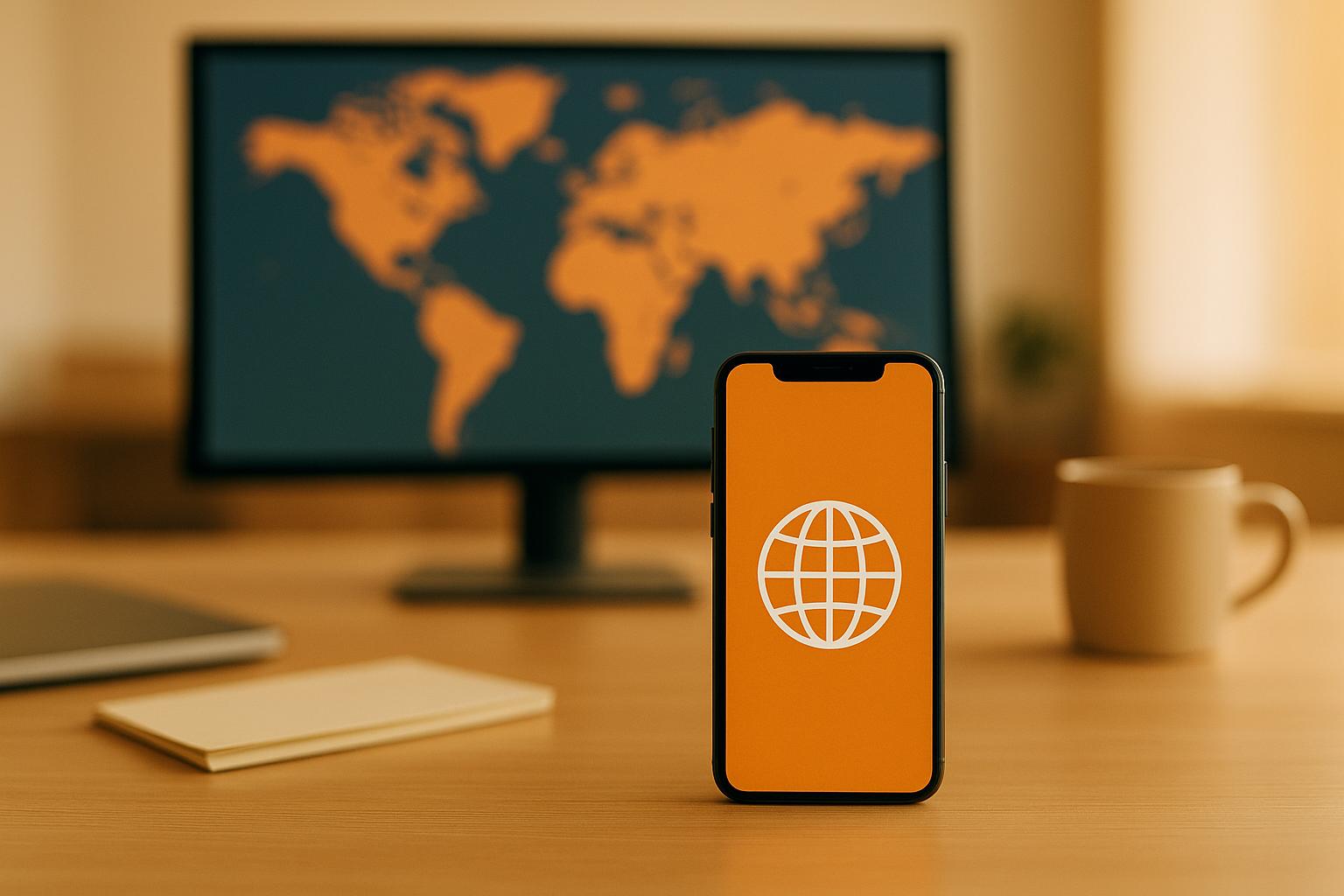How Businesses Save on Telecom with Global eSIMs
https://www.zimconnections.com/how-businesses-save-on-telecom-with-global-esims/
 SHARE
SHARE
Global eSIMs are helping businesses cut telecom costs by up to 30%, especially for international operations. They reduce roaming charges, provide access to local rates worldwide, and simplify expense management – all while improving connectivity for remote teams. Here’s why they matter:
- Lower Roaming Costs: Businesses can save up to 50% on roaming fees by connecting to local networks instead of relying on expensive roaming agreements.
- Transparent Pricing: Avoid hidden fees and overcharges with predictable, location-based data plans.
- Simplified Management: Manage multiple profiles and monitor usage on a single platform, reducing admin overhead by 30%.
- Sustainability Benefits: eSIMs eliminate the need for physical SIM cards, reducing plastic waste and emissions.
For UK businesses, adopting eSIMs means smoother telecom operations and significant savings. Platforms like ZIM Connections offer affordable plans starting at £1, with coverage in over 200 destinations. Transitioning to eSIMs is straightforward: check device compatibility, choose the right plan, and provide staff with clear onboarding resources. With these steps, businesses can optimise telecom costs while staying connected globally.
The Hidden Business of Roaming and eSIM Cards
How Global eSIMs Cut Telecom Costs
Global eSIMs are proving to be a game-changer for businesses looking to manage telecom expenses effectively. By addressing common cost challenges, they provide measurable savings through three main benefits: cutting down roaming charges, accessing local rates globally, and simplifying expense management.
Reducing Roaming Charges and Hidden Costs
One of the standout advantages of global eSIMs is their ability to significantly lower international roaming fees. Unlike traditional SIM cards that lock users into expensive roaming agreements, eSIMs let devices connect to local networks at local rates, no matter where you are in the world. According to Juniper Research, businesses using eSIM technology can slash international roaming fees by as much as 50%.
Real-world examples back this up. A multinational consulting firm reported a 40% drop in roaming costs within just a year of switching to eSIMs. Similarly, a financial services company achieved a 45% reduction in the same period. With dynamic data plans tailored to location, duration, and usage, eSIMs also eliminate the unpredictability of traditional roaming charges.
Accessing Local Rates Anywhere
Global eSIMs give businesses access to local network rates across multiple countries without the hassle of swapping physical SIM cards. This approach not only avoids the steep costs of international roaming but also provides greater financial transparency. Research by Analysys Mason found that companies adopting eSIM solutions could cut roaming charges by up to 50% and reduce overall telecom expenses by 20%.
Examples from the field underline these savings. XYZ Corporation reported a 30% reduction in mobile costs during its first year using eSIMs, while ABC Enterprises, a tech startup with a remote workforce, saved 40% on overall mobile expenses. This kind of flexibility also enables finance teams to predict costs more accurately, helping businesses stay on budget. Administrative tasks are simplified too, making expense management more efficient.
Streamlining Telecom Expense Management
Beyond cutting costs, eSIMs make telecom expense management far less complicated. Traditional SIMs often require dealing with multiple carriers, invoices, and usage reports. eSIMs, on the other hand, centralise these processes, offering real-time visibility into data usage and costs.
For instance, a technology firm reported a 30% drop in administrative overhead after moving to eSIMs. IT teams can monitor and adjust data plans instantly, identify savings opportunities, and manage everything from a single platform – no waiting for monthly bills. eSIMs also allow multiple profiles on a single device, making it easy to separate business and personal use. A global logistics company saw a 35% reduction in annual telecom expenses after rolling out eSIMs across its international driver fleet. These operational efficiencies go beyond just saving money – they also boost productivity and streamline operations.
Business Benefits Beyond Cost Savings
Global eSIMs bring more to the table than just cutting costs. They reshape how businesses operate by improving workforce efficiency, aligning with environmental goals, and enhancing security measures.
Easy Connectivity for Remote Workers
Global eSIMs have revolutionised connectivity for remote teams and employees who travel frequently. Unlike traditional SIM cards that need to be physically handled, eSIMs allow instant activation of local carrier plans via centralised platforms.
The impact on productivity is striking. Remote workers using eSIMs experience a 35–40% productivity boost and a 40% reduction in errors. This improvement is due to the uninterrupted connectivity eSIMs provide, whether employees are working from home, at the office, or abroad.
With eSIMs, IT departments can manage and adjust connectivity remotely through a single platform, eliminating the need for physical intervention. When Wi-Fi isn’t available, features like hotspot and tethering ensure employees stay connected.
This reliable connectivity also supports flexible work arrangements, which have been linked to increased profitability. Companies adopting these setups report 21% higher profitability, while employees save an average of 72 minutes daily that would otherwise be spent commuting. These benefits align with broader business objectives, including sustainability and security.
Supporting Environmental Goals
eSIMs also play a role in tackling environmental challenges. The production of 4.5 billion plastic SIM cards annually generates over 18,000 tonnes of non-recyclable waste. Switching to eSIMs can cut individual carbon footprints by up to 90%. If just 10% of global mobile users adopted eSIMs, it could prevent more than 40,000 tonnes of plastic waste each year. Widespread adoption could eliminate millions of tonnes of waste by 2030.
Real-world examples highlight these benefits. In 2022, Apple’s eSIM-only iPhone 14 and Vodafone’s 15% reduction in SIM-related waste showcased how eSIMs contribute to greener practices. The telecommunications sector, responsible for 0.4% to 4% of global CO₂ emissions, is increasingly adopting sustainable alternatives, with companies like KORE Wireless and Thales leading efforts to reduce SIM production waste.
Better Security and Compliance
Security is another critical area where eSIMs excel. Traditional methods often expose businesses to risks, such as the 42% of business travellers who connect to insecure public Wi-Fi networks. eSIMs address these vulnerabilities with built-in security features. Since they are integrated into devices, they cannot be physically removed or tampered with.
Advanced identity verification through signed digital certificates helps prevent fraud, while encrypted communication channels protect data between devices and carrier servers.
Remote management adds another layer of security. IT teams can update or deactivate eSIM profiles from anywhere, ensuring compliance with security protocols even during international travel. eSIMs also meet various regulatory standards, such as GDPR in Europe and CCPA in the United States, and adhere to GSMA security protocols like SGP.01, SGP.02, and SGP.21/22.
Additionally, eSIM technology provides audit trails and monitoring tools, making it easier for businesses to track activity and meet compliance reporting requirements. For companies operating across regions, eSIM-enabled routers ensure secure, localised connectivity that complies with data privacy laws, offering consistent protection no matter the location.
sbb-itb-273ea09
How UK Businesses Can Adopt Global eSIMs
Adopting global eSIMs offers more than just cost savings – it opens the door to smoother operations and improved connectivity. However, for UK businesses to make the most of this technology, careful planning is essential. Success hinges on addressing key areas like device compatibility, selecting the right plans, and ensuring employees are well-supported throughout the transition.
Checking Device Compatibility
Before diving into eSIM adoption, it’s crucial to confirm whether your devices are compatible. Not all eSIM-capable devices are created equal. Factors like phone model, manufacturer, and even carrier-specific customisations can affect compatibility. For instance, some devices listed as eSIM-ready may not support it due to modifications by manufacturers or carriers.
To check compatibility, start by exploring device settings for eSIM options:
- iPhone: Go to Settings > Cellular.
- Samsung: Navigate to Settings > Connections > SIM Card Manager.
- Google Pixel: Check Settings > Network & Internet and look for the “+” symbol next to SIMs.
Alternatively, dial *#06# to see if your device displays an eSIM unique identification number (EID) – a clear sign of compatibility. Keep in mind that some iPhones from Mainland China don’t support eSIM technology.
Also, verify that devices are carrier-unlocked. On iOS, check Settings > General > About > Carrier Lock – if it says “No SIM restrictions”, the device is unlocked. For Android, look under Settings > Network & Internet > Mobile Network for multiple carrier options. If you’re unsure, reach out to the device manufacturer, vendor, or carrier for confirmation.
Selecting the Right eSIM Plans
After confirming device compatibility, the next step is choosing an eSIM plan that fits your business needs. Look for plans that provide reliable global coverage, competitive pricing, and robust network performance in key locations where your business operates. For example, ZIM Connections offers coverage in over 200 destinations with plans starting at just £1 – making it an affordable option for businesses of all sizes.
Network performance can vary by region, so researching provider reliability in critical areas is essential. Additionally, simple activation processes can make life much easier. ZIM Connections, for instance, provides instant digital activation, helping businesses avoid unnecessary delays.
Security is another critical factor. Choose providers with strong encryption and flexible terms, allowing you to switch providers without being tied down by long-term contracts or penalties.
| Factor | Key Considerations | ZIM Connections Advantage |
|---|---|---|
| Coverage | 200+ destinations globally | Extensive international reach |
| Pricing | Starting from £1 | Affordable plans |
| Activation | Instant digital setup | Hassle-free, quick activation |
| Support | 24/7 customer service | Assistance across multiple time zones |
For larger organisations, multi-SIM plans can simplify management by consolidating multiple connections under one contract. It’s also worth assessing technical aspects like compatibility with 2G, 3G, 4G, and 5G networks to ensure smooth operations.
Employee Training and Support
Introducing eSIM technology to your workforce requires more than just technical set-up – it calls for effective employee training. Since many team members might be unfamiliar with eSIMs, provide clear instructions through guides and video tutorials. These resources should cover steps like scanning QR codes, entering activation codes, naming eSIM profiles, and switching between plans.
In 2024, a mid-sized UK financial services firm transitioned to eSIMs for its travelling sales team. The IT department created step-by-step guides, held training sessions, and produced video tutorials. Within weeks, the sales team adapted seamlessly, and the IT team noted easier mobile management.
Appoint someone in your IT team to handle advanced queries and common troubleshooting tasks, such as verifying eSIM activation or adjusting APN settings. A quick FAQ can also help employees address basic issues independently, reducing the need for constant IT intervention.
Given the global nature of many businesses, ensure your eSIM provider offers 24/7 support. Backup contact methods are essential for situations where online assistance isn’t available. This level of support not only simplifies activation but also enhances security, preventing unauthorised eSIM profile additions to work devices.
Conclusion: Global eSIMs Transform Business Telecom
Global eSIMs are reshaping the way businesses approach telecommunications by cutting costs and simplifying operations. Studies reveal that companies adopting eSIM solutions can save an average of 20–30% on telecom expenses, with some organisations reporting even greater financial benefits.
The financial advantages are particularly striking when it comes to reducing roaming charges. Businesses have seen roaming costs drop by as much as 45%, while overall annual telecom expenses have decreased by around 30–35%. For companies with extensive international operations, these savings can make a noticeable difference to their bottom line.
But it’s not just about saving money. eSIMs bring a level of operational efficiency that traditional SIM cards simply can’t match. Features like remote provisioning and activation eliminate the hassle of managing physical SIM cards, while centralised platforms offer real-time insights into usage and costs. These capabilities help businesses streamline their telecom management significantly.
On top of that, eSIMs contribute to environmental goals by doing away with the need for physical SIM cards. This reduces plastic waste and transportation emissions, aligning with broader sustainability initiatives.
Platforms like ZIM Connections highlight how eSIMs are driving this change. Offering coverage in over 200 destinations and competitively priced plans, they make global connectivity and telecom management more accessible than ever.
This shift is more than just a cost-cutting measure. It enhances operational flexibility and supports sustainability goals, while positioning businesses for a future where eSIM technology becomes the norm. Wholesale roaming revenue is expected to grow from roughly £7.2 billion in 2024 to about £16 billion by 2028, with most new devices expected to feature embedded SIMs by then.
For UK businesses looking to lower telecom costs while supporting remote work and international operations, global eSIMs present a clear solution. With measurable results and comprehensive support from platforms like ZIM Connections, the transition to smarter, more efficient connectivity has never been easier. Global eSIMs offer a forward-thinking way to meet the evolving demands of today’s telecom landscape.
FAQs
How do global eSIMs help promote environmental sustainability in telecom?
Global eSIMs contribute to a greener planet by doing away with the need for physical SIM cards. This change not only reduces plastic waste but also helps lower electronic waste (e-waste). By cutting out the production and shipping of traditional SIM cards, eSIMs significantly decrease the carbon emissions tied to manufacturing and logistics.
Beyond this, eSIMs also lessen the environmental footprint of telecom operations. Without the reliance on physical components, companies can embrace more sustainable practices while maintaining effortless global connectivity. This shift represents a step towards a cleaner, more responsible approach to communication technology.
How can UK businesses effectively adopt global eSIMs to reduce telecom costs?
To make the most of global eSIMs, UK businesses should begin by assessing their telecom needs and pinpointing employees who often travel abroad. It’s crucial to ensure that your team is equipped with eSIM-compatible devices. Partnering with a reliable provider like ZIM Connections, known for offering flexible plans designed for international connectivity, can make a significant difference.
To ensure a hassle-free transition, train your staff on how to activate and manage eSIMs effectively. A phased rollout is a smart strategy – start by introducing the service to a smaller group. This allows you to fine-tune the process, tackle any issues early on, and optimise cost savings, all while keeping your team connected without interruptions.
How can businesses confirm if their devices support eSIM technology before switching?
To determine whether your device supports eSIM technology, start by visiting the official websites of manufacturers like Apple, Samsung, or Google. These sites typically provide detailed compatibility information. Most newer smartphones, particularly flagship models launched since 2018, are equipped with eSIM functionality.
Another way to check is through your device settings – look for eSIM-related options – or by scanning a QR code from an eSIM provider. Confirming compatibility in advance ensures a hassle-free switch to eSIM technology, especially for businesses.









































































































































































































